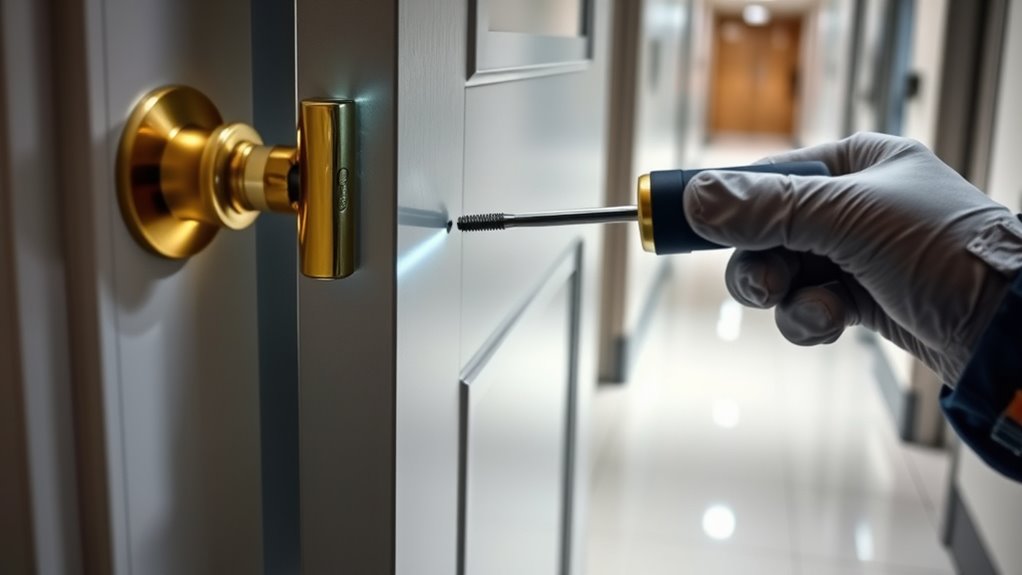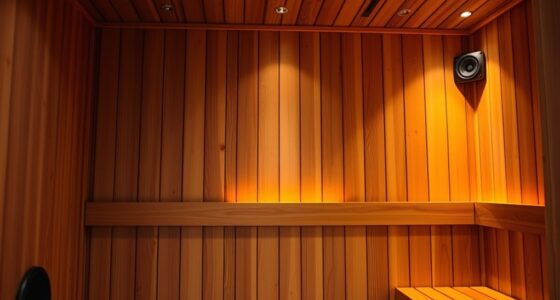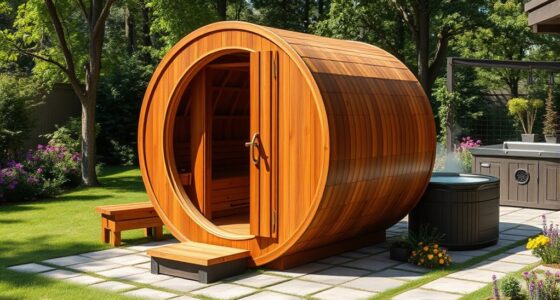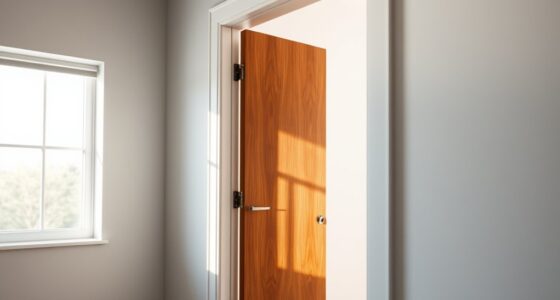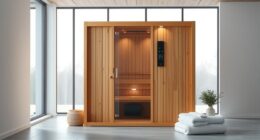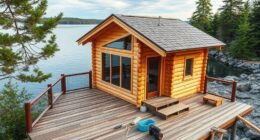To quickly improve your door’s swing and safety, start by inspecting the hinges for dirt, rust, or looseness. Tighten any loose screws and remove hinge pins if needed for cleaning or replacement. Apply a quality lubricant like silicone spray to keep hinges moving smoothly and prevent rust. Adjust misaligned hinges or strike plates to ensure proper latch alignment. Keep these tips in mind, and you’ll boost your door’s performance in just 15 minutes. Find out more, and you’ll master every step.
Key Takeaways
- Inspect hinges for dirt, rust, or looseness; tighten or replace hinge screws as needed.
- Lubricate hinges with silicone spray or household oil to ensure smooth door swing and reduce squeaks.
- Check and adjust the strike plate to align with the latch, preventing sticking or misalignment.
- Test door operation and address any sagging or sticking issues promptly through hinge realignment.
- Regularly clean and inspect hinges to maintain safety, prevent rust, and ensure smooth, secure door movement.
Diagnosing and Adjusting Door Hinges for Smooth Operation
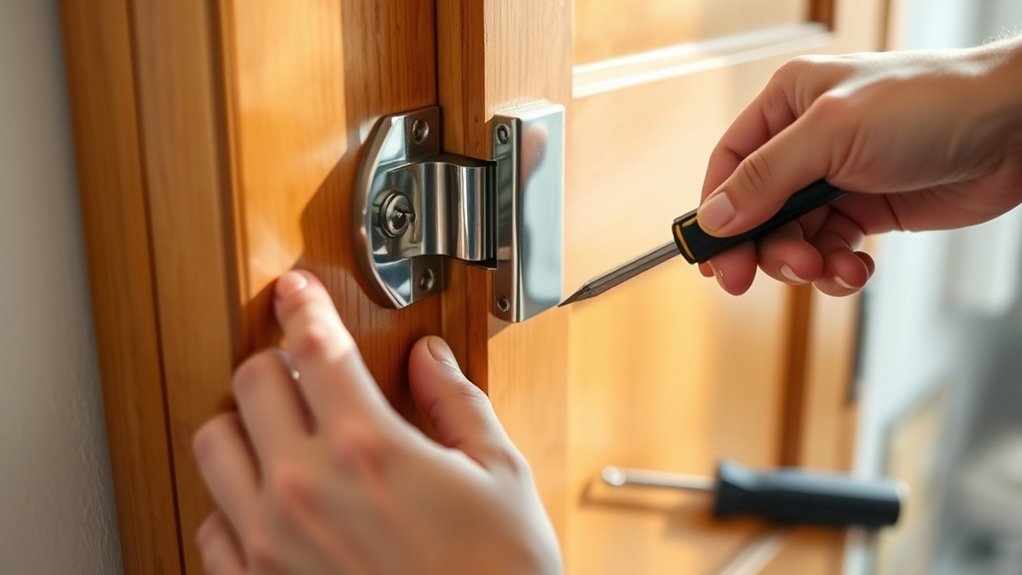
If your door squeaks, sticks, or doesn’t close properly, the problem often lies with the hinges. Start by inspecting them for dirt, rust, or looseness. Applying hinge lubrication can reduce squeaks and allow smoother movement. Use a silicone spray or household oil, carefully applying it to the hinge pins and joints. If the door still doesn’t swing freely, consider a door latch adjustment; sometimes, misaligned hinges cause the latch to catch or not close fully. Tighten loose hinge screws with a screwdriver, but avoid overtightening, which can warp the hinge. For more persistent issues, remove the hinge pins, clean or replace them, then reassemble. Proper hinge maintenance guarantees your door opens and closes smoothly, avoiding future problems. Additionally, using high-quality lubricants can prolong the effectiveness of hinge lubrication and prevent rust buildup over time.
Ensuring Proper Door Alignment and Swing Clearance
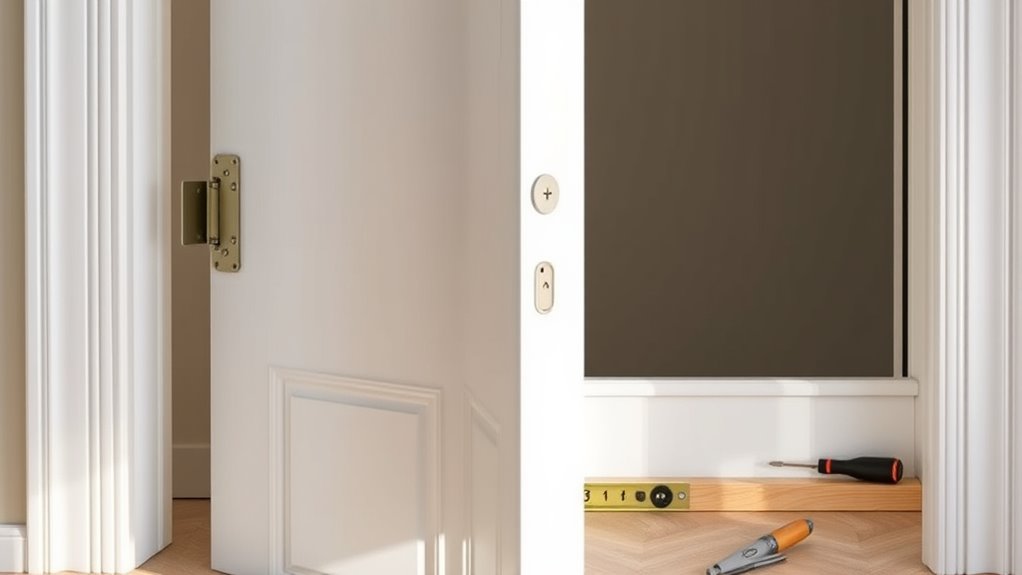
Proper door alignment and swing clearance are essential for smooth operation and preventing damage. First, check the door’s hardware lubrication; ensure hinges and moving parts are well-lubricated to reduce friction. If the door sticks or sagging, adjust the hinges or strike plate to improve alignment. Pay close attention to the lock mechanism repair—misaligned locks can cause uneven swinging or difficulty closing. Make sure the latch aligns correctly with the strike plate without forcing the door. Clear any obstructions that might impede the swing path. By maintaining proper hardware lubrication and fixing lock mechanism issues, you ensure the door swings freely and closes securely. Regular adjustments help prevent long-term damage and keep your door functioning smoothly in just minutes. Additionally, understanding how contrast ratio influences door glazing or panels can assist in selecting appropriate materials for aesthetic and functional purposes.
Frequently Asked Questions
Can I Fix Door Swings Without Professional Tools?
Yes, you can fix door swings without professional tools. Start by inspecting the door lock repair area and checking the hinges for loose screws. Tighten any loose hinges with a screwdriver, and if the door isn’t aligning properly, consider adjusting the door frame repair by sanding or repositioning the hinges slightly. These simple steps help improve door swing and safety without needing specialized tools.
How Often Should Door Hinges Be Lubricated?
Imagine a squeaky door that never stays quiet—sounds frustrating, right? You should lubricate your door hinges every six months as part of your maintenance schedule. Regular hinge lubrication keeps your doors swinging smoothly and prevents sticking or squeaking. Skipping this simple step can lead to more costly repairs later. Stay proactive with a quick hinge lubrication routine, and your doors will operate quietly and efficiently for years to come.
What Signs Indicate a Door Hinge Needs Replacement?
If your door hinge squeaks, feels stiff, or won’t swing smoothly even after lubrication, it’s time to think about replacement. Watch for excessive rust, corrosion, or visible damage to the hinge pin or plates. When the hinge makes noise, resists movement, or shows signs of wear, replacing it ensures safety and smooth operation. Don’t wait until it completely fails—address these signs promptly to prevent further issues.
Are There Safety Precautions for Adjusting Heavy Doors?
Adjusting heavy doors is like taming a wild beast, so safety comes first. You should wear proper safety gear—gloves, goggles, and steel-toed boots—to protect yourself. Always follow emergency procedures, like having a buddy nearby or knowing how to quickly shut off power if needed. Use proper tools and avoid rushing. Your careful approach guarantees you control the job safely without risking injury or damage.
How Do Weather Changes Affect Door Alignment?
Weather impact and seasonal shifts can cause your door to misalign over time. Changes in temperature and humidity cause materials to expand or contract, which may lead to sticking, uneven gaps, or difficulty closing. You should regularly inspect and adjust the door hinges and frame to maintain proper alignment. Staying aware of weather patterns helps you anticipate and address these issues promptly, ensuring your door remains safe and functional year-round.
Conclusion
By quickly diagnosing and adjusting your door hinges, you can guarantee smooth operation and safety in just 15 minutes. Did you know that improperly aligned doors can cause up to 10% more energy loss? Taking these simple steps not only improves functionality but also saves you money on energy bills. So, don’t wait—spend a few minutes now to prevent bigger issues later and enjoy a safer, more efficient space.
